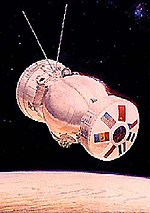Kosmos 1129
This article relies largely or entirely on a single source. (March 2014) |
 Conception of Bion 5 in orbit. | |
| Mission type | Bioscience |
|---|---|
| Operator | Institute of Biomedical Problems |
| COSPAR ID | 1979-083A |
| SATCAT no. | 11536 |
| Mission duration | 18.5 days |
| Spacecraft properties | |
| Spacecraft type | Bion |
| Manufacturer | TsSKB |
| Launch mass | 6,000 kilograms (13,000 lb) |
| Start of mission | |
| Launch date | 29 September 1979, 15:30:00 UTC |
| Rocket | Soyuz-U |
| Launch site | Plesetsk 41/1[1] |
| End of mission | |
| Landing date | 14 October 1979, 02:24 UTC |
| Landing site | 52°17′N 65°30′E / 52.283°N 65.500°E near Oktyabr'skoe, Kazakhstan, Soviet Union |
| Orbital parameters | |
| Reference system | Geocentric |
| Regime | Low Earth |
| Eccentricity | 0.01344 |
| Perigee altitude | 226 kilometres (140 mi) |
| Apogee altitude | 406 kilometres (252 mi) |
| Inclination | 62.8° |
| Period | 90.5 minutes |
| Epoch | 29 September 1979[2] |
Bion 5, or also Cosmos 1129 (in Russian: Бион 5, Космос-1129) was a Bion satellite. It was a biomedical research mission involving scientists from nine countries. Among the experiments was the first attempt to breed mammals in space, which proved unsuccessful. The mission ended after 18.5 days. The mission had the cooperation of the former Czechoslovakia, East Germany, France, Hungary, Poland, Romania and the United States.
Mission
Organisms studied included:
- Rattus norvegicus (Wistar rat)[3]
- Coturnix coturnix (Japanese quail)
- Daucus carota (carrot)
Objectives
Bion 5 mission consisted of various biological studies, including the first mammalian reproduction attempts (rats) in space, which ended up not succeeding. Experiences NASA were designed to study the effects of radiation on mice, quail embryos and some plant specimens.
Studies on the effect of microgravity were also performed on the muscles and bones of rats and avian embryogenesis was studied in space. the effects of microgravity on plant tissues were investigated using carrots and carrot cancerous tissue to study the effects of space flight on the growth and development of plants. As in the previous mission, 30 rats for the species Rattus norvegicus were sent physiological studies; Seven additional rats were used in embryological experiments.
See also
Bibliography
- Kozlov, D I (1996). Mashnostroenie, ed. Konstruirovanie avtomaticheskikh kosmicheskikh apparatov. Moscow. ISBN.
- Melnik, T G (1997). Nauka, ed. Voenno-Kosmicheskiy Sili. Moscow. ISBN.
- "Bion' nuzhen lyudyam". Novosti Kosmonavtiki (6): 35. 1996.
References
- ^ Gunter Dirk Krebs. "Bion (12KS)". Gunter's Space Page. Retrieved 16 June 2020.
- ^ NASA Goddard Space Flight Center. "Bion 5". NSSDCA Master Catalog. Retrieved 16 June 2020.
- ^ NASA Contractor Report 3922(27), USSR Space Life Sciences Digest, Issue 23
External links
- Cosmos 1129. NASA
- Bion satellites
- Kosmos satellites
- Spacecraft launched in 1979
- 1979 in spaceflight
- 1979 in the Soviet Union
- Czechoslovakia–Soviet Union relations
- Romania–Soviet Union relations
- Hungary–Soviet Union relations
- Poland–Soviet Union relations
- France–Soviet Union relations
- Soviet Union–United States relations
- East Germany–Soviet Union relations
- Soviet Union spacecraft stubs
